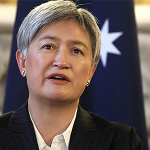Leaders of NATO countries and the EU, courtesy of the U.S. Mission to the North Atlantic Treaty Organization.
NATO members have never paid their share of Europe’s defense. President Trump demanded they pay, and the Ukraine war scared them into doing so, but they still depend on the US.
The Ukraine war is a prime example: Ukraine is in Europe, yet the US is funding its defense to prevent a broader threat to other European countries. With a GDP of around $16 trillion, the EU can afford to pay. Meanwhile, US defense resources are spread across multiple theaters. NATO’s 31 member countries have 3.5 million soldiers and a significant number of tanks, planes, ships, and other assets. They could alleviate some of the burden on the US but choose not to.
Europe is largely dependent on the United States for its security, as the US provides most of the funding, firepower, and intelligence that NATO utilizes for its defense strategies. Historically, NATO has focused on defending Europe from Russia, but the US has global foreign policy objectives. The US views China as the greatest threat to its national interests, with Russia being second. Consequently, the US must allocate significant military resources to contain China, which, in turn, spreads its resources thin when assisting NATO and Europe.
It’s bad enough that Europe cannot defend itself and must rely on the US, but after 70 years of US protection, it would be helpful if the European allies could now assist the US against China. NATO is gradually recognizing the China threat and the Moscow-Beijing alliance makes this threat to Europe more apparent. However, Europe is not yet prepared to identify China as an enemy.
NATO’s defense strategy is contingent upon various strategic documents published by the United States Department of Defense, the Department of State, and the intelligence community. US national security is guided by the National Security Strategy (NSS), the National Defense Strategy (NDS), the Indo-Pacific Strategy, and the Nuclear Posture Review. Similarly, NATO’s strategy is driven by the NATO Strategic Concept and the Secretary General’s Annual Report. All these US strategic documents were updated in 2022, and NATO updated its Strategic Concept in the same year, demonstrating NATO’s need to coordinate with US strategy.
The National Defense Strategy (NDS) outlines the Department of Defense’s strategic approach to global security challenges, focusing on the primary threats to U.S. national security. It prioritizes strengthening alliances, increasing lethality, and reforming the Department to enhance efficiency. The NDS emphasizes competition with near-peer adversaries such as China and Russia, while also addressing threats from rogue states and non-state actors.
The United States National Security Strategy (NSS) outlines how the United States plans to advance its vital interests and address global challenges. It emphasizes strategic competition, particularly with China and Russia, and outlines plans to strengthen alliances, invest in American power and influence, and modernize the military.
The Indo-Pacific Strategy underscores the importance of the Indo-Pacific region to global security and outlines US efforts to strengthen alliances and partnerships in the region. It aims to ensure a free and open Indo-Pacific, counter China’s influence, and maintain regional stability.
The 2022 Nuclear Posture Review (NPR) reaffirms the role of nuclear weapons in deterring nuclear attacks on the US, its allies, and partners. It highlights the need for a safe, secure, and effective nuclear deterrent while also emphasizing efforts to reduce nuclear risks. This review identifies Russia and China as key nuclear adversaries and outlines plans for modernizing the US nuclear arsenal.
The NATO Strategic Concept The NATO Strategic Concept 2022 outlines priorities for the next decade, addressing the changing security environment and main threats. It emphasizes collective defense, crisis management, and cooperative security while tackling emerging threats like cyberattacks, space security, and climate change impacts.
Where the US produces a standalone Indo-Pacific Strategy document, NATO’s Indo-Pacific strategy is included in its Strategic Concept and described in greater detail in the Strategic Foresight Regional Perspectives Report, published in the same year as the US Indo-Pacific Strategy.
These documents highlight the region’s global security importance, focusing on engagement with key regional partners (Australia, Japan, South Korea, and New Zealand). They address security challenges from China’s influence but stop short of identifying China as an enemy.
Additionally, NATO’s engagement with Indo-Pacific nations includes areas like maritime security, cyber defense, and upholding the rules-based international order but does not extend to mutual defense agreements. NATO does not even conduct freedom of navigation patrols, despite 70% of global shipping passing through the Indo-Pacific region.
When Trump complained that the US pays for nearly all of NATO’s funding, the press attacked him, citing the exact dollar amount the US contributes to the organization. However, the US financial commitment to NATO goes far beyond direct contributions. NATO heavily relies on US intelligence for strategic planning.
The US intelligence community provides a comprehensive Annual Threat Assessment that evaluates current threats to national security. Additionally, the US publishes specific annual reports like “Military and Security Developments Involving the People’s Republic of China.” NATO does not produce similar reports, not even an annual report on security developments involving Russia, NATO’s primary adversary.
NATO and Europe have had a free ride for 70 years, relying on US intelligence reports, defense and security resources, and funding. With the US involved in costly conflicts in Ukraine and Israel, defending Taiwan, engaging the Houthis, conducting freedom of navigation patrols to keep the Indo-Pacific open to commercial shipping, and preparing for possible wars with China, Russia, and Iran, it’s time for NATO and Europe to declare China an enemy, step up, and share the financial and military burden of defense.
The post NATO Needs to Step Up: National Security Policy Misalignment appeared first on The Gateway Pundit.








